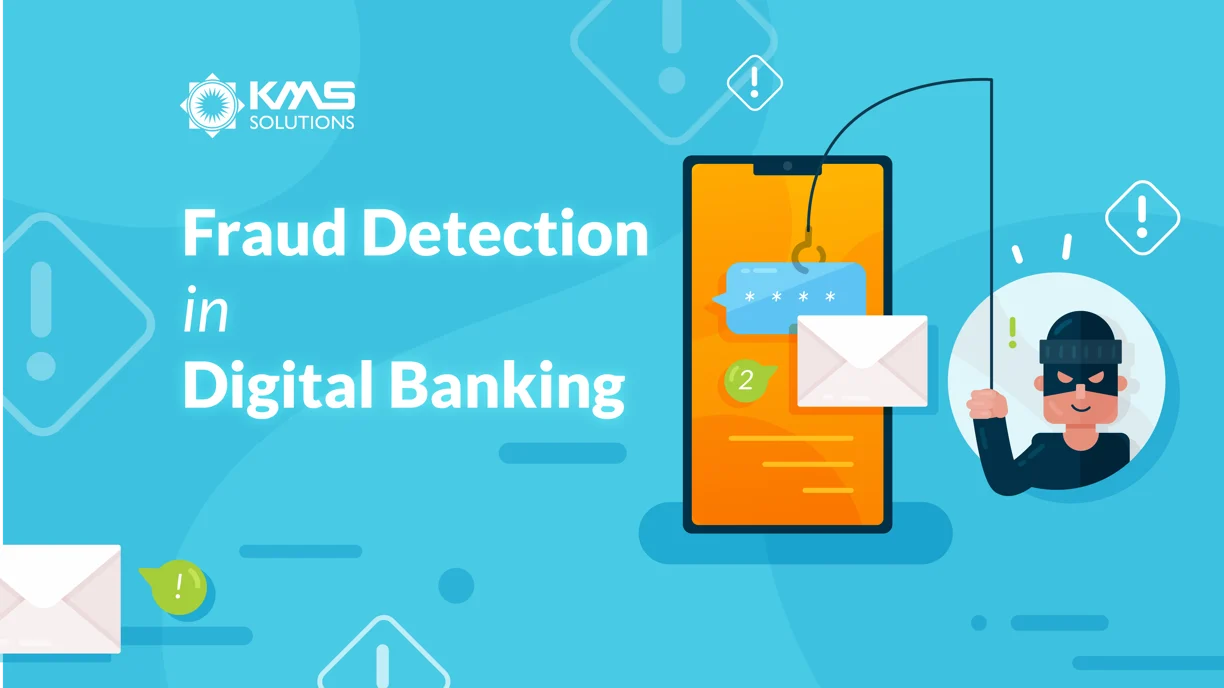Fraud Detection is an integral component of eKYC (electronic Know-your-Customer). Fraud Detection is vital during the online onboarding process, as it helps banks prevent costly frauds and cybercrimes.
As Mobile banking apps grow in number, so do the ways that fraudsters can do wrong. And their fraud tactics will continue to multiply given that banks have to adopt Open Banking, eKYC, and PS2D (Europe’s second Payment Services Directives). To prevent these unauthorized transactions, a robust fraud detection system is a must have feature for a Mobile Banking App.
In the first part, this article gives you a brief overview of fraud detection. The rest will discuss mobile banking application development with Machine Learning.
What is fraud detection?
Fraud Detection is all about identifying and preventing fraudulent activities.
In more technical terms, Fraud Detection is a form of pattern detection. It identifies abnormal patterns that deviate from expected behaviors. Usually, these abnormal patterns would be labeled as “fraudulent” or “suspicious” transactions and behaviors.
All sectors that are possible targets of fraudsters and identity thefts can benefit from Fraud Detection.
For banks, Fraud Detection has become all the more important. Most of the banks are now adopting eKYC and expanding digital channels. These are all vulnerable environments where identity frauds, forged (photoshopped) ID documents, email phishing, or synthetic IDs are common.
Now that there are myriad ways someone can commit fraud, organizations are looking to enhance fraud detection through advanced data analysis and ML.
Fraud detection techniques
Today’s fraudsters normally trick organizations’ security practices by repeating a wide range of methods. Moreover, there are so many of them, making manual checking neither effective nor possible. This is why advanced data analysis and ML to detect fraudulent attempts are the core of today’s fraud detection technologies. For example, a bank can identify patterns of fraudulent activities during online onboarding by embedding algorithms in their eKYC.
As technicalities of fraud detection are not the scope of this article, we will just give a brief introduction to some popular fraud detection techniques.
In general, fraud detection techniques can be separated by the use of either data analysis or AI, or both.
Data analysis techniques for fraud detection include:
- Using statistical parameters to build data models
- Regression analysis
- Probability distributions and models
- Data matching
AI techniques used for fraud detection include:
- Data mining – classifying, grouping, and segmenting data to search through transactions to find patterns and detect fraud.
- Neural network – learning suspicious patterns and using those patterns to detect them further.
- Machine Learning – Automatically identify characteristics found in fraud.
- Pattern recognition- detecting classes, clusters, and patterns of suspicious behaviors
Fraud Detection in Digital Banking
Fraud has forever been a concern for banks. A failure to detect fraud does not only lead to costly compensations and lawsuits even, but also damages banks’ reputations. In PwC’s report in 2020, respondents reported a total loss of $42 billion over a period of 24 months. They also failed to take corrective actions, since only 56% proceeded to investigate their worst fraud.
While the digital banking era offers new opportunities to delight your mobile banking customers, it also is the breeding ground for new forms of banking fraud. By shifting from branch-based to omnichannel operations, banks have created a new environment for criminals.
It’s true that Digital Banking has become a must: it helps banks reduce costs while introducing an omnichannel experience, where customers can use banking services anytime and anywhere. However, Digital Banking exposes banks to security threats. This is because customers often lack knowledge of online security risks. As a result, they are easily scammed into disclosing their confidential data to criminals, who use the data to trick banks and commit fraud.
On the other hand, digital banking channels are just so attractive to fraudsters. The enormous online transactions mean that traditional fraud detection no longer works. Hungry to capitalize on that, fraudsters become ever more sophisticated with their tricks.
Although banks are making heavy investments into digital services, they can fail to allocate resources to secure their systems. Lacking a sufficient fraud detection system, banks find it impossible to prevent dubious transactions. Moreover, the two-factor authentication may be effective, but it is expensive, plus not really user-friendly.
Banks need an alternative approach to fraud detection, one that is not only faster but more secure also.
The traditional way banks approach fraud detection
Traditionally, banks rely on rules-based fraud detection systems, coupled with manual checking to detect frauds.
In this approach, banks define rules, which are typically the common attributes of suspicious transactions or behaviors. They include unusual account numbers, transaction types, or transaction amounts. If a transaction or behavior has these attributes, they would be flagged as “fraudulent”. If they do not, they are passed as “non-fraudulent”.
In other words, rules-based fraud detection is like a gatekeeper, it lets some in and rejects others.
Back then, this method of fraud detection worked just fine. But recently it proves to fail regularly and provides inconsistent results, along with unacceptable false positives (as in when the system reject legitimate customers) and false negatives (as in when the systems accept fraudsters)
The reason is that fraudsters and cybercriminals are getting smarter and smarter, beyond what rules-based fraud detections can handle. Other problems with this method are due to the huge volume of data that banks process, which can cause frauds to go undetected.
Moreover, rules-based fraud detection relies largely on analysts, which are typically expensive. The accuracy of the systems will also depend on the experience, skills, and knowledge of these experts.
Fortunately, banks can resolve these shortcomings by applying machine learning to their fraud management systems.
The machine learning approach to fraud detection in banks
Machine learning (ML) means applying algorithms that learn and recognize patterns in data. In terms of fraud detection and prevention, ML can benefit banks greatly, as they can automatically and accurately discover patterns across huge volumes of transactions. In general, fraudulent transactions have patterns that are different, although very subtly, from genuine ones. Machine learning algorithms aim to detect these suspicious patterns and thus distinguish fraudsters from legitimate clients.
Thanks to ML, banks can identify transactions most likely to be fraudulent, while ensuring false positives stay at an acceptable level.
How machine learning helps fraud detection
A fraud detection system with machine learning algorithms collects and segments historic data. It analyzes all data about transactions and customers that are labeled as good (legitimate) or bad (fraudulent).
This data is then used to “teach” the ML how to tell if a given transaction or captured ID document is fraudulent. For ML fraud detection to be intelligent enough, banks need to have as much data (both of legitimate and fraudulent transactions) as possible to give the system enough examples to learn from. It also must be updated from time to time, of course, as it is not perfect.
If banks were to build an ML fraud detection themselves, they would need data scientists to improve and maintain the system. This is why there are banking organizations, instead of developing their fraud detection systems out of their in-house resources, choose to buy it from a third-party vendor.
Benefits of machine learning in fraud detection for banks
Without machine learning, most tools and systems rely on humans to analyze data, and thus makes them more prone to problems such as low performance and high FAR (False Acceptance Rate) or FRR (False Rejection Rate). Machine learning can solve some of these problems.
Benefits of machine learning for banks include:
- Speed – Machine learning is able to work with large data. Banks need this given the gigantic amounts of transactions and client information they process day-to-day.
- Efficiency – Machine learning can automate repetitive tasks and identify even the most subtle anomaly in data patterns. Furthermore, ML algorithms can analyze hundreds of thousands of payments per second, which is more work than rules-based systems and humans can handle.
- Accuracy – As the number of transactions and customers onboarding increases for banks, so does the pressure on a rules-based system and human analysis. This means a rise in time and a reduction in accuracy. The situation is reversed with machine learning algorithms. The ML Fraud Detection improves itself as more data comes in, making it faster and more accurate in detecting frauds.
Conclusion
The race between fraudsters and banks is getting more intensive. The smarter and more sophisticated cyber-fraud becomes, the better its ability to fool banks’ traditional fraud detection systems.
It follows that banks must keep updating their strategies for identifying and preventing frauds. As we learn in this article, the most advanced fraud detection practices are to use machine learning to not only automate but also increase the accuracy of their capability to combat fraud.








